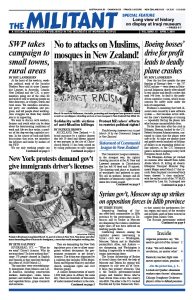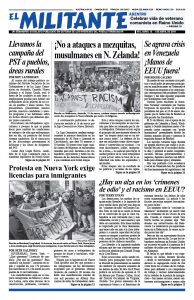Over the last five months the new flagship of Boeing’s fleet — the 737 MAX airliner — went down in Ethiopia and Indonesia shortly after takeoff in two similar and deadly crashes that took 346 lives. At fault is the profit-driven capitalist system, which tosses concern for safety aside under the lash of competition.
Evidence is mounting that both disasters were caused by a new software system — that becomes active without the crew’s knowledge or training — repeatedly forcing the planes into what became uncontrollable dives.
Yet for three days after the crash in Ethiopia, Boeing, backed by the U.S. Federal Aviation Administration, continued to claim that the planes were safe to fly. At stake are market share and profits worth hundreds of billions of dollars in an expanding global airline industry, as the U.S. aerospace giant is locked in ongoing rivalry with European-based Airbus.
The Ethiopian Airlines jet crashed six minutes after takeoff from Addis Ababa March 10, killing all aboard. Ethiopian Transport Minister Dagmawit Moges noted March 17 that records from the plane’s recovered black boxes showed “a clear similarity” with the earlier crash of the 737 MAX operated by Lion Air. It plunged into the Sea of Java off Indonesia Oct. 29.
The Chinese government, presiding over what is about to become the world’s largest aviation market, was the first to ground the Boeing plane the day after the crash. Dozens of other governments in Asia and the Pacific, Europe and Latin America followed suit. Boeing shares spiraled down, while Airbus stocks rose. Despite a personal plea from the CEO of Boeing to let the plane keep flying in the U.S., President Donald Trump announced March 13 that the FAA was halting flights of the new airliner.
Boeing bosses came under pressure in 2011 to respond when American Airlines decided to order Airbus’ A320neos instead of the 737. This was a new, more fuel efficient jet. Boeing dropped plans for a new single-aisle aircraft, and scrambled instead to install new generation engines and upgrade software in its top-selling 737. This kept the basic 50-year-old airframe design, saving the bosses massive new capital investment.
However, to avoid them scraping the ground, the new larger engines had to be mounted jutting forward and higher on the wings, causing a change in lift aerodynamics. This required the company to design a computer system “fix” to compensate for the plane’s tendency to nose up into a stall when under full power at lower speeds, as just after takeoff.
After the crash in Indonesia, it was revealed that neither Boeing’s flight manuals nor the FAA-approved pilot training for the 737 MAX explained that the new software system was designed to automatically take over if it received data indicating a potential stall. Without proper training, the crew wouldn’t know the system was activated even as the computer forced the plane’s nose down. Dealing with this has been described by experienced pilots as fighting “a bucking bronco.”
Cutting corners in drive for profit
Boeing’s selling point for the new model was that airlines could avoid expensive long pilot simulator training. Pilots trained on the older 737, the world’s most widely used commercial jet, were required only to do an “IPad lesson for an hour,” Dennis Tajer from the Allied Pilots Association at American Airlines told the press.
If triggered by false readings from just a single sensor, the new system can unexpectedly and repeatedly override manual flight controls. If the pilots don’t know how to disable it — and they weren’t trained on this — the result can be an uncontrollable dive.
As part of a growing practice of “self-regulation,” the FAA delegated more of its airworthy safety assessments over to Boeing’s own engineers. This expedited FAA approval of the 737 MAX and its new feature, named the “Maneuvering Characteristics Augmentation System.”
“They have sold this aircraft on the basis that if you can fly” earlier model 737s, “you can fly this,” aviation consultant Neil Hansford told the March 16 Australian. This is part of the trend for modern jetliners to be increasingly automated, dumbing down pilot inputs, a deadly trap in an emergency.
After the Indonesian crash, Tajer said that Boeing’s withholding of crucial information was a “failure of the safety culture.” Since the crashes, numerous pilots’ reports flagging problems in both the flight control systems and in pilot training programs for the new plane have become public. After the Ethiopian crash, two flight attendants unions called for the planes to be grounded.
For workers control of production
Inside the giant Boeing plant near Seattle, where the push is on for workers to continue producing 52 of the 737 MAX planes a month, the two crashes are being widely discussed.
“The company told workers not to talk to the press,” a worker employed on the 737 MAX line, who didn’t want to give his name for fear of reprisal from Boeing bosses, told the Militant. If they did, he said, they would face “consequences for their job.”
“The industry has a pattern of putting profits ahead of safety,” he said. “The unions of the pilots, flight attendants and machinists need to have a voice in the safety of the planes. We need union control of safety on the job.”
It will take fighting working-class action to win workers control of production at every level, from aircraft design to air crew training. This is the only road to make flying safe in an era of intensified capitalist competition and cost-cutting.

